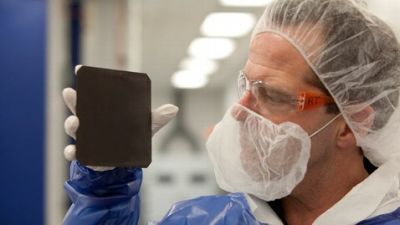Black silicon gets attention at IEEE
 Natcore Technology and the National Renewable Energy Laboratory presented a paper on their cutting-edge black silicon solar at the Institute of Electrical and Electronics Engineers June 4.Natcore and NREL have partnered to develop a special antireflective property in silicon solar cells without covering them in a toxic coating. Reducing reflectivity of a solar cell increases its efficiency and energy output.
Natcore Technology and the National Renewable Energy Laboratory presented a paper on their cutting-edge black silicon solar at the Institute of Electrical and Electronics Engineers June 4.Natcore and NREL have partnered to develop a special antireflective property in silicon solar cells without covering them in a toxic coating. Reducing reflectivity of a solar cell increases its efficiency and energy output.
Being selected for the presentation was an honor, said Chuck Provini, Natcore CEO. “It’s a very, very prestigious organization,” he said. The paper also helped to unite Natcore further with NREL, which Provini said is good for both organizations and the solar industry in general.
Scientists from both organizations spoke about how NREL invented the technology and how Natcore found a way to make it work. But the paper did more than present black silicon. “It’s illuminating in some ways how we’re going to need to change the way solar cells are made,” Provini said.
Solar panels need an anti-reflective coating that is currently applied with heat from furnaces. Those furnaces are expensive, difficult to mange and produce toxins. “Our process eliminates the need for that reflective coating and gets rid of those toxins,” Provini said.
Solar is a young and immature industry, Provini said. In order for it to mature to the point where it can compete in the United States, where fuel prices are low, a few things will have to happen. It will have to become more efficient and affordable, which everyone says. But the world will also have to find a way to make solar cells without so many toxins.
It’s not such an issue now when solar makes up such a small sliver of energy production, but it will be. “If we start making solar panels in quantum numbers, we have to deal with that,” Provini said.
Natcore’s wet bench in Rochester, New York has a hazmat rating of 0, Provini said. And Natcore is working on developing the technology so it can be used to build solar cells from the bottom up.
For now, though, the company is en route to commercializing its first black silicon machine. Provini said Natcore is deciding between four companies to partner with. “Before the end of the year there will be a black silicon machine on someone’s line,” he said.



